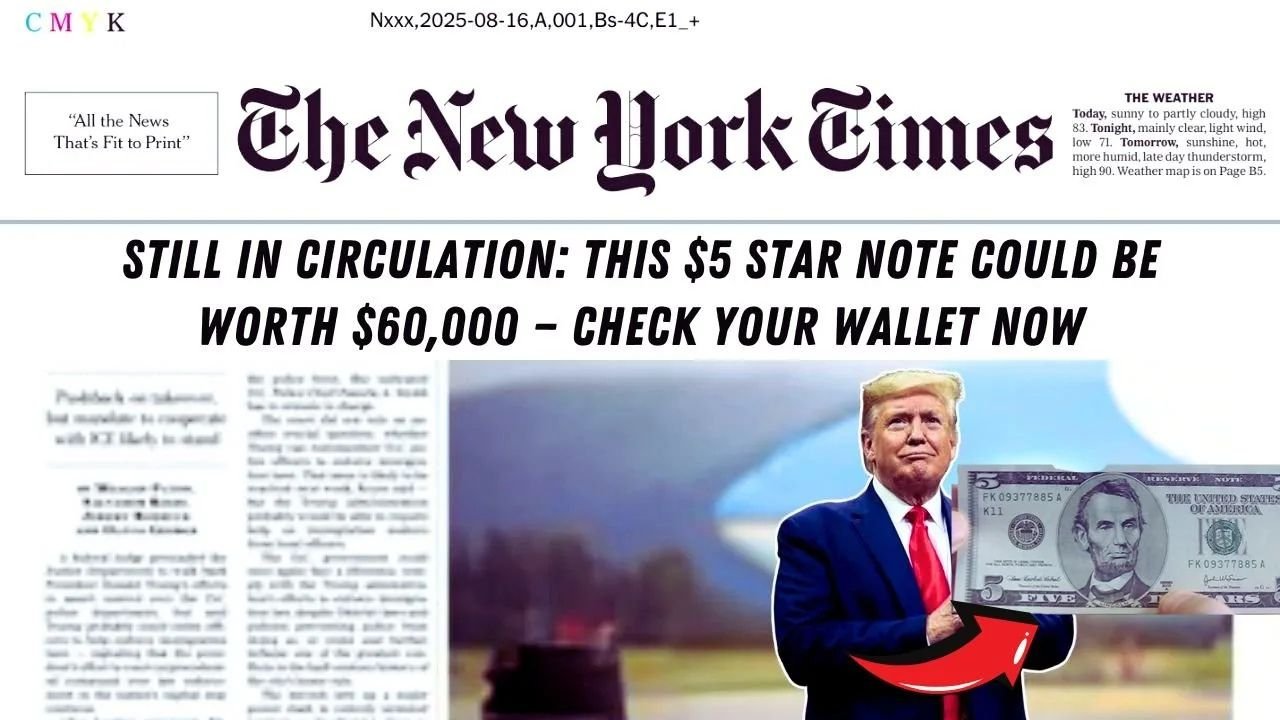Have you ever checked the cash in your wallet for hidden treasures? A rare $5 bill, known as a star note, could be worth thousands—potentially up to $60,000! These special bills are catching the eyes of collectors across the U.S., and you might have one tucked away in your pocket or purse. Let’s dive into what makes star notes so valuable, how to spot one, and what to do if you find a potential goldmine.
What Are Star Notes and Why Are They Special?
Star notes are U.S. currency with a unique twist: a small star symbol at the end of the serial number. The Bureau of Engraving and Printing creates these notes to replace bills damaged or misprinted during production. Since fewer star notes are made, they’re rarer than regular bills, making them a hot commodity among collectors.
What sets star notes apart? It’s all about rarity and uniqueness. Some have low serial numbers, repeating digits, or come from specific years that collectors prize. A star note in pristine condition can fetch a price far beyond its face value, turning a humble $5 bill into a small fortune.
The $5 Star Note That Could Change Your Life
One standout example is the 1969 $5 star note, which recently sold at auction for an incredible $60,000. Its value skyrocketed due to its rarity, a low serial number, and uncirculated condition. Not every star note will make you rich, but certain ones—especially from specific series or with unique serial numbers—can be worth serious cash.
Here’s a quick look at some notable $5 star notes and their potential value in uncirculated condition:
| Year | Series | Potential Value (Uncirculated) |
|---|---|---|
| 1969 | $5 Star Note | Up to $60,000 |
| 1934 | $5 Star Note | $500 – $2,000 |
| 2003 | $5 Star Note | $50 – $200 |
Note: Values vary based on condition, serial number patterns, and market demand. Always consult an expert for an accurate appraisal.
How to Identify a Valuable Star Note
Ready to check your wallet? Here’s how to spot a potentially valuable $5 star note:
- Look for the Star: Check the serial number on your $5 bill. A star symbol (*) at the end marks it as a star note.
- Check the Year: Older series, like 1969 or 1934, are often more valuable. Newer ones, like 2003, may still fetch a premium if rare.
- Examine the Serial Number: Look for unique patterns, such as:
- Low numbers (e.g., 00000001)
- Repeating digits (e.g., 77777777)
- “Solid” numbers (all the same digit)
- Assess Condition: Bills that are crisp, uncreased, and free of tears or stains are worth more.
- Get a Professional Opinion: If you suspect your bill is rare, take it to a currency dealer or appraiser for a detailed evaluation.
Handling your bill carefully is key—any damage can lower its value significantly.
Where to Sell Your Rare Star Note
Found a star note that might be valuable? Here’s how to turn it into cash:
- Online Marketplaces: Platforms like eBay or Heritage Auctions are great for selling rare currency. Research recent sales to set a fair price, and verify buyer credibility to avoid scams.
- Local Coin Shops: Visit a reputable dealer for an in-person appraisal and offer. Bring any documentation or research you’ve done.
- Currency Shows: These events attract collectors and dealers eager to buy rare bills. Check for shows in your area.
- Preserve Condition: Store your bill in a protective sleeve and handle it minimally to maintain its value.
Before selling, compare recent sales of similar star notes to gauge your bill’s worth. Knowledge is power when negotiating with buyers!
Don’t Let Hidden Cash Pass You By
Your everyday cash could be hiding a treasure. While most $5 star notes won’t make you a millionaire, rare ones like the 1969 series could be life-changing. Take a moment to check your wallet, purse, or that dusty cash jar at home. You never know—you might be holding a $60,000 bill!
If you’re unsure about a bill’s value, don’t hesitate to consult a professional. A quick appraisal could uncover a payday you never expected.
FAQ: Your Questions About Star Notes Answered
What is a star note?
A star note is a U.S. bill with a star symbol in the serial number, used to replace damaged or misprinted bills during production.
How do I know if my $5 star note is valuable?
Check the year, serial number, and condition. Rare years like 1969 or unique serial numbers (e.g., repeating digits) can increase value. Get it appraised by a professional.
Where can I sell a rare star note?
Sell on platforms like eBay or Heritage Auctions, at local coin shops, or at currency shows. Research recent sales to set a fair price.
Are all star notes worth a lot?
Not all star notes are valuable. Value depends on rarity, year, serial number, and condition. Some may only be worth their face value.
How do I protect my star note?
Store it in a protective sleeve, avoid folding or touching it excessively, and keep it away from moisture or heat to preserve its condition.




